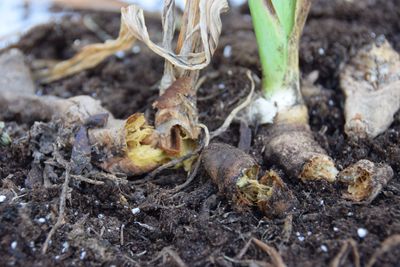Root Rot in Iris
Root root in iris is also known as soft rot, and if your irises have ever had it, you know why. The leaves become soft, and the rhizome root grows mushy. Iris root rot is a caused by Erwinia carotovora, a bacterial phytopathogen. It usually gets inside the rhizome through an opening created by some kind of injury. Any pest could provide this entry, including borers, slugs, snails, beetle larvae or even rough use of tools. With iris root rot, you’ll first see yellowing at the center of the fan of leaves. In time, the center turns brown and collapses. Root rot in iris always produces a mushy, bad smelling rhizome. Often, you’ll also see decay in the plant’s leaves.
Preventing Rotting Iris Roots
Iris root rot is not easy to cure. However, many times you can avoid it by using good cultural practices in your garden. First, make sure that your irises are planted in sunny sites. Good soil drainage is critical, so consider raising your beds if need be to ensure proper drainage. Adequate spacing between rhizomes is also important since overcrowded plants are more vulnerable to bacterial growth. Don’t plant your rhizomes too deep in the soil, and keep dirt from the base of the fans. Never use fresh manure on your iris plants, especially if drainage is a problem. Instead, feed your plants with gentle fertilizers.
How to Treat Iris Rot
If you want to know how to treat root rot, it means your irises are already under attack. You’ll need to dig up each diseased rhizome and inspect it carefully. If the iris root rot is extensive, destroy the iris rhizome. Unfortunately, this is the only method of root rot control in iris if the rot has spread. You can learn how to treat root rot that is not so extensive, however. For less seriously affected plants, cut out and dispose of all parts of the rhizome that are diseased. Use sterilized tools to do this, and sterilize them again after use to prevent spreading the bacteria.
